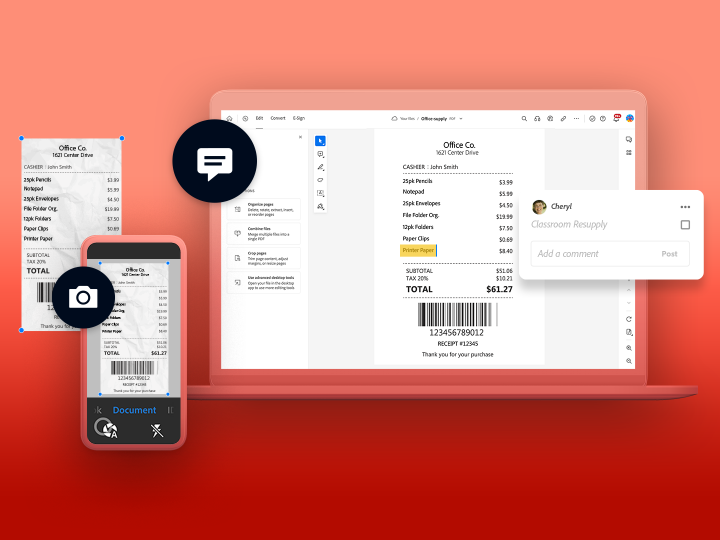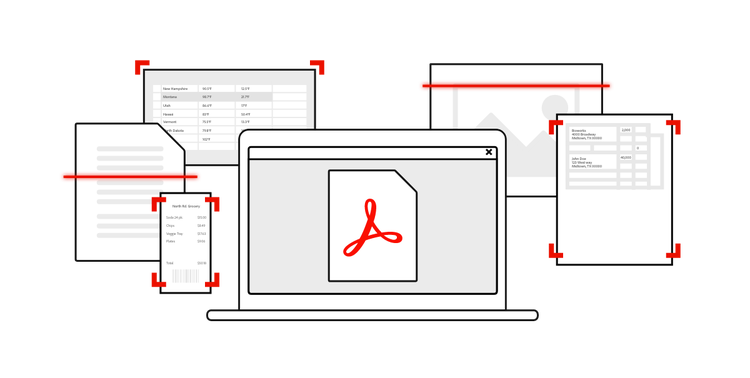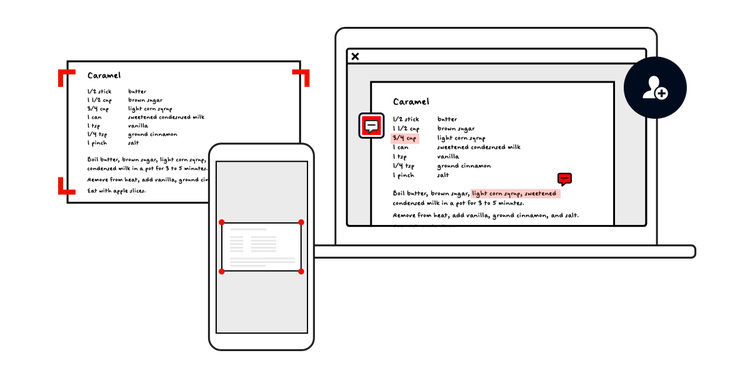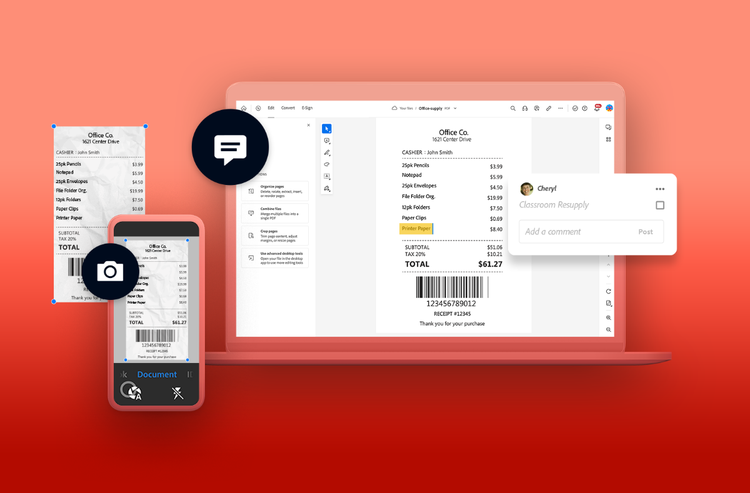ACROBAT
What is OCR and why is OCR software important?
Learn how OCR can transform printed documents into digital files.

Optical character recognition (OCR) is sometimes referred to as text recognition. It’s been around for almost 50 years — but the more technology has seeped into our work, the more prevalent technology has become in our daily lives.
Technologies have allowed our work and personal projects to travel with us from our office spaces, to our homes, to virtually any destination in the world. Technological growth has made it possible for more people to have a say in the direction our world moves in. Convenience and ease are the names of the game in the content and technology world. OCR allows static content to transform into a smart, searchable file.
What is OCR?
Optical character recognition (OCR) is a technology that changes printed documents into digital image files. It is a digital copy machine that utilises automation to transform a scanned document into machine-readable PDFs that you can edit and share. An example of OCR would be when you scan a receipt with your computer. Your computer will then save the scan as an image. While you cannot search, edit or count the words in the image, you can use OCR to change the image to a text document with the content saved as text. OCR programmes can pull data from camera images, image-only PDFs and scanned documents. It makes static content adjustable and eliminates the need for data to be entered manually.
Why is OCR important?
While our world largely exists in the digital realm, most businesses still use print media. This includes documents such as invoices, contracts, scanned legal documents and other paper forms. Paper documents take up a lot of physical space as well as time and effort to manage. Paperless documents are becoming more widely used across businesses. Scanning documents into images can be time-consuming as it requires manual input. OCR saves individuals and businesses time and money by converting images into text data that is able to be read by other business software. This technology streamlines operations, can conduct analytics, automates processes and improves overall productivity.
Blind and visually impaired users.
In addition to the convenience of being able to scan and search text, OCR provides better access for users who are blind and visually impaired. The OCR recognition process accounts for language and structure and corrects words that it sees as being spelt incorrectly. Its spell-checking technology allows for the most accurate information to be conveyed to users. OCR contains a synthesizer within its system that will speak the recognised text. The content can be accessed by someone who is blind or visually impaired through scanned text using adaptive technology devices that will magnify the computer screen or provide the user with speech to listen to or Braille to read. Through the software, text from scanned documents can be read aloud according to each individual’s specifications.
How optical character recognition works.
An OCR software or engine works through a set of steps.
1. Image analysis — A scanner reads a document and changes it into binary data. The OCR software will inspect the scanned file and classify light areas as the background and dark as the text.
2. Pre-analyzation — the OCR technology perfects the image through some different techniques:
- Smoothing the edges of text images and taking away digital image spots.
- Fixing any alignment issue that occurred during the scan by tilting the scanned document.
- Recognising script for multilingual OCR technology.
- Tidying up lines and boxes in the image.
3. Recognising text — OCR technology processes text by using feature extraction and pattern matching:
- Feature extraction breaks down the linguistics into components such as closed loops, lines, line direction and line intersections. From there, it uses these components to search for the best match or its closest one.
- Pattern matching is when a character image, called a glyph, is isolated and compared to a similar glyph that is already stored. Pattern recognition can only operate when the glyph that is stored has a similar scale and font to the glyph that is added. This method works best with images that are scanned from documents that have been typed in a font that is already known.
4. Post processing — After the content is analysed, the system changes the extracted text data to be a computerized file. Some OCR software can make annotated PDFs that have before and after versions of a scanned document. When OCR doesn’t recognise text, make sure that you check that your scan is high-quality, with plenty of light and that the scan is not skewed.
History of OCR technology
This document-transforming technology was developed in 1974 by Ray Kurzweil, who started Kurzweil Computer Products, Inc. This new technology could recognise text that was printed in just about any font. Kurzweil determined that the best use for his technology would be a machine learning device for those who are blind. He made a reading machine that was able to read text out loud and translate text into a text-to-speech format. He sold his company to Xerox in 1980, as Xerox was interested in continuing to commercialise paper-to-computer text transformation.
This technology was not popularised until the early 1990s, when it was being used to digitise historical newspapers. OCR has seen several developments since this time. Today, OCR has the capability to give users nearly perfect accurate conversions. Document processing workflows are able to be automated through advanced methods of OCR. Before this software was available, documents had to be manually retyped — taking much more time, effort and resources. With that, there was a higher chance of errors in the content. OCR is widely accessible today and continues to increase efficiency for personal and professional purposes.
Types of OCR technology
Data scientists will distinguish different types of OCR software depending on their application and use. Here are a few examples:
- Simple optical character recognition software stores different text and font image patterns as templates. This software will use pattern dash-matching algorithms to find the differences between text images. It will analyse character by character in its internal database. Optical word recognition is when the system replicates the text word by word. It is not possible for every font and handwriting style to be captured as there are unlimited amounts of both, so this solution has its limits.
- Intelligent character recognition (ICR) software is a part of modern OCR technologies. ICR reads text the same way humans read it. Using machine learning software, machines can be trained to act like humans. A machine learning system called a neural network studies text and processes images repeatedly. It searches for image aspects such as lines, curves, loops and intersections and puts together the outcome of the different levels of data to get a final conclusion.
- Intelligent word recognition technologies work on the same rules as ICR, but those technologies study whole word images rather than pre-modifying the images into characters.
- Optical mark recognition finds watermarks, logos and other text signs in a document.

OCR use cases
One of the most popular uses for OCR is print media conversion to machine-readable text documents. Other use cases for OCR include helping visually impaired and blind people access content, automation for data and listing documents for search engines such as licence plates, invoices, passports and more.
Best OCR software for both home and business
Here are some of the best OCR software options for both home and business purposes:
1. Adobe Acrobat Pro DC
Acrobat Pro provides all the OCR tools you need to streamline workflows and ensure efficiency in document management. With the Pro version of Acrobat, you have all the basic OCR features you need along with the ability to comment and leave feedback on documents, the option to compare two documents, a special tool for scanning tables and more. Documents can be adjusted on your computer screen seconds after they are scanned. Acrobat OCR pairs well with the free Adobe Scan app — you can scan documents and transform them into PDFs. Text will automatically be recognised and you can adjust as needed with help from the Adobe OCR tools.
2. OmniPage Ultimate
This software is known for its high accuracy in conversions. OmniPage Ultimate allows you to build customised workflows so your documents will automatically be delivered to the right location in the right format.
3. Abbyy FineReader
Abbyy FineReader gives you all the tools you need to transform paper documents into digital ones. This software can recognise text and convert it to PDF and different Microsoft Office formats as well as other ones. You can compare documents, add annotations, comments and more. This software can convert a large number of documents in batches and can handle many output formats and 192 different languages.
4. Readiris
Readiris can support many different file formats and add signatures and security protections to your documents, along with comments, watermarks and annotations.
5. Rossum
This OCR solution was made for scanning invoices for important information to be exported into whichever programme you’re using. This software uses AI to scan a document for important information rather than using a template format. This helps because different invoices could be formatted differently to present information in different ways.
Real-world OCR applications
There are multiple OCR software and tools available for different day-to-day personal and professional needs.
- Layout analysis software divides scanned documents into sections that are appropriate for OCR.
- OCR engines identify characters.
- Software development kits that add OCR abilities to other software. Some examples include document imaging management systems, record management solutions or form processing applications.
- Graphical interfaces on one or more OCR engines.
OCR in business
Document creation and collaboration are important parts of business functionality. As businesses grow, workload grows with it. While more employees are usually added to the team, there are some tasks that can be taken off of people’s plates through this convenient technology.
By eliminating the need for manual data entry with certain tasks, efforts can be focused on other important business tasks. Through automated data extraction and storage capabilities, businesses can improve workflows and efficiency. Costs are reduced and data is more centralised and secure being digital. Businesses can use OCR to bring data to an Excel sheet to easily view content online in an organised fashion. With content online, there is less risk of documents getting lost or stolen. Everyone can more easily be on the same page, as digital documentation makes it easy for all to have the most up to date information.
OCR technology in education
OCR software serves as a great tool to help students with their studies. Here are a few examples of how it can assist in education:
- Note-taking becomes easier as OCR speaks words out loud to transform the text to speech.
- Changes can be made to the colours or size of the text.
- Words, sentences and paragraphs can be highlighted.
- Digital bookmarks can be placed so students can easily move around through the text.
OCR is a great tool to help students who have dyslexia. A paper homework sheet can be scanned to be transformed into a digital document. The students can use tools to assist with reading the document.
OCR in healthcare
In the healthcare industry, OCR is used to handle patient records such as tests, hospital records, treatments and insurance payments. This technology helps by streamlining workflow and decreasing the amount of manual labour the industry has to take on. OCR makes record management easier and ensures content is up to date. The time required to add data to electronic records becomes shorter and the accuracy of the data entered increases. OCR leaves less room for error in data entry.
OCR can assist in retrieving information from electronic health records (EHRs). For example, a patient’s medical history may be stored in an EHR and a doctor would need to access the information. With an OCR search, they could quickly retrieve the information they needed. Paper medical records can be scanned and digitised so that healthcare professionals can access the information they need with ease. This technology can be used to scan prescriptions and other important documents to reduce the chance of errors and keep patients safe. Digital forms can be made through OCR to save paper and time — and make document management easier.
OCR and machine learning — what’s next?
OCR and machine learning have grown exponentially over the past couple of decades and will only continue to see improvements over the coming years. The next generation of OCR is built using machine learning and artificial intelligence that is not limited to the character-matching software of previous software. OCR software will continue to think and learn more on its own.
Not only will OCR technology continue to perceive scanned text, but it will also find the text’s meaning and make sense of the content. Machine learning may be an idea of the past as deep learning continues to develop and transform OCR technologies. Deep learning technologies are composed of neural networks that imitate human brain functionality to verify that algorithms don’t need to depend on historical patterns to confirm accuracy. Deep learning means the technology can do this on its own and not only see the text but find the meaning behind it.

How OCR helps streamline processes and increases efficiency.
Manual labour, time and cost can be decreased through OCR software and technologies. Converting stagnant documents to digital, smart, searchable documents can help companies provide a better experience for their customers and employees by making information easier to find. By integrating OCR technologies into your business model, you can:
- Transform handwritten documents into editable digital documents.
- Scan forms that were filled in by hand to automate reviews, verifications, analysis and editing. Time can be saved on the manual processing of documents and data entry.
- Look for important documents by quickly searching a phrase in the database — and there’s no need to manually go through physical files.
- Secure and centralise data as digital documents have a lower chance of being lost or stolen.
- Obtain the most accurate and up to date information.
Through OCR technology, ease and accessibility increase and businesses can serve their client bases better — while taking the pressure off employees.
